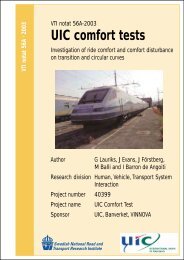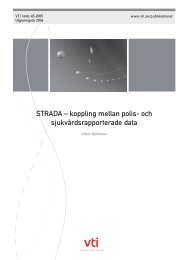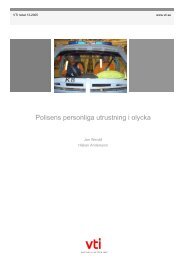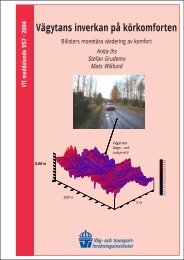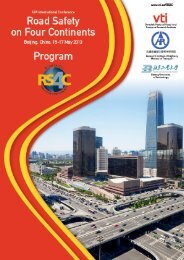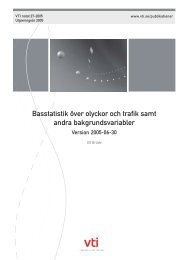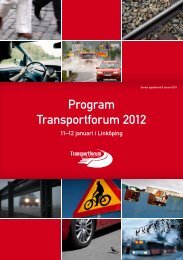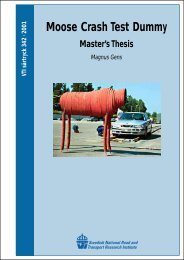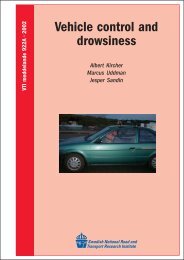Missing text /vti/pages/publication/downloadpdf for sv
Missing text /vti/pages/publication/downloadpdf for sv
Missing text /vti/pages/publication/downloadpdf for sv
- No tags were found...
You also want an ePaper? Increase the reach of your titles
YUMPU automatically turns print PDFs into web optimized ePapers that Google loves.
the residence and the barrier. For the rest of the town’s inhabitants the location oftheir home has little importance. Their valuation of getting rid of the barrierdepends on how often they visit the area next to the barrier.(2a) WTP = α 1 – γ 1 X 1 <strong>for</strong> those living close to the barrier(2b) WTP = α 2 + γ 2 X 2 <strong>for</strong> those living in the rest of the townwhere X 1 is a distance variable and X 2 is a variable <strong>for</strong> the frequency of visitingthe area next to the barrier. The values of α 1 , α 2 , γ 1 and γ 2 depend on Z, i.e. thecharacteristics of the road or railway constituting the barrier such as trafficvolumes and road or rail track width. We have arrived at the conclusion that Y-variables <strong>for</strong> socio-economic variables are not needed in the calculation model.The average age and sex distribution are almost the same in different urban areas,and it is not reasonable that income in a particular district should have asignificant influence on the benefit of eliminating an existing encroachment bymeasures financed by taxes.Having now completed this project, we have reached an important sub-goal.We have developed a questionnaire design and know which variables areimportant <strong>for</strong> the WTP to avoid encroachment costs. We also know in principlehow to design the calculation model. To be able to develop a complete calculationmodel, however, it is necessary to per<strong>for</strong>m a few additional case studies. We hopethen to be able to finally explain the expected variations found in our studies inthe α- and γ-values by barrier characteristics, Z. With this addition, it would bepossible to work out the final calculation model <strong>for</strong> ”barrier to water”. Ourobjective then is to build calculation models <strong>for</strong> the remaining typical casesdescribed in the report.A calculation model <strong>for</strong> road or rail barriers at the waterfront would be veryuseful as a complement to the present CBA model. An inventory shows that thereare more than 100 cases in Sweden where a road or a railway constitutes such abarrier. Extending the current CBA with an encroachment calculation modelwould make it possible to tell where and when earlier encroachments should becorrected by diverting the traffic into a new route and eliminating the barrier. It isof course also possible to use the model to avoid making new encroachmentswhen making new investments in transport infrastructure.8 VTI meddelande 939



